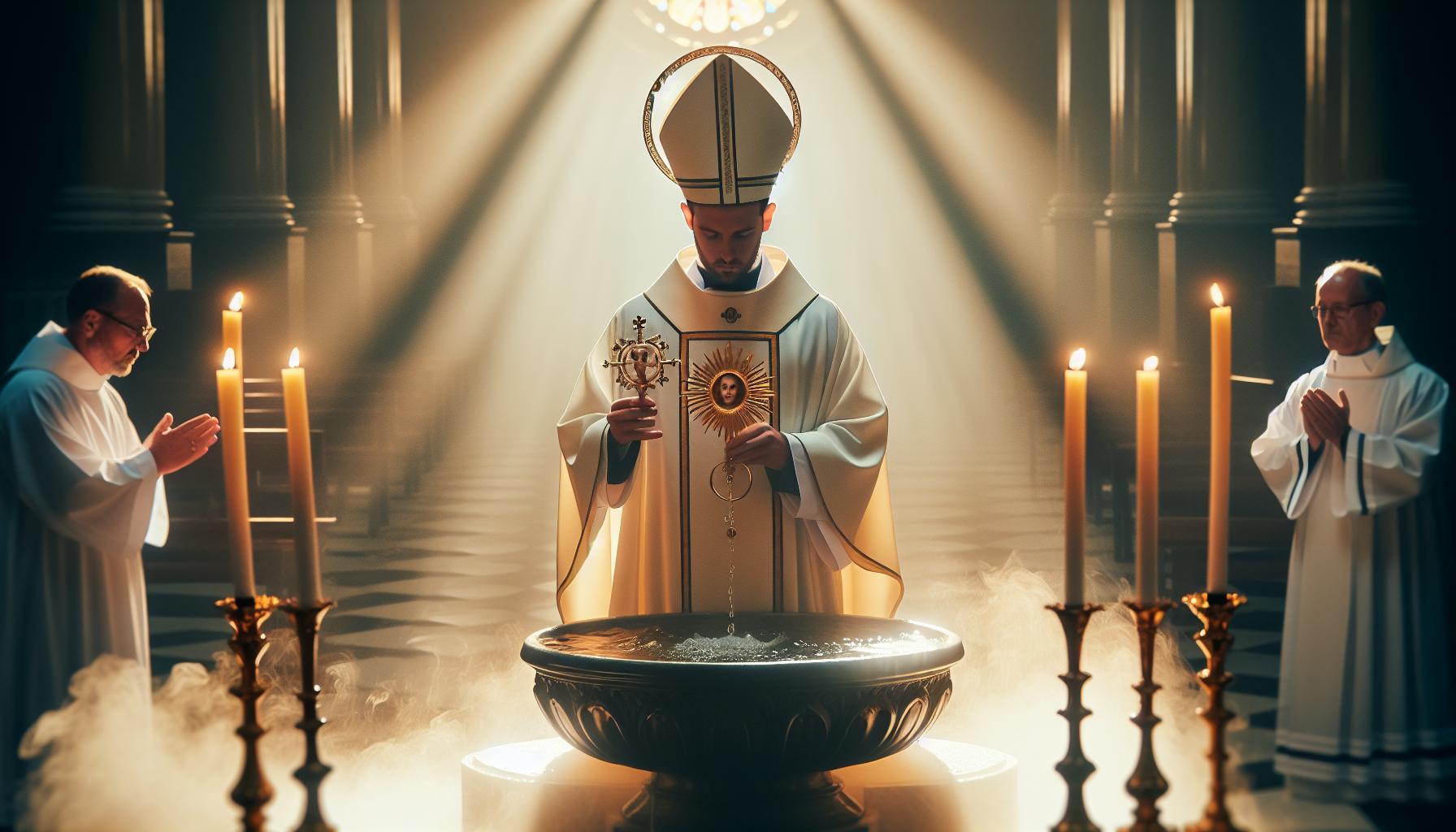Baptism serves as a profound declaration of faith and commitment, yet many wonder why it holds such significance in the Christian journey. This sacred rite not only symbolizes a believer’s new life in Christ but also unifies the community of faith. Understanding its purpose enriches both personal and communal spiritual experiences.
The Spiritual Significance of Baptism: Understanding Its Role in Faith
Baptism holds profound spiritual significance within the Christian faith, representing a pivotal moment of transformation and commitment. As individuals immerse themselves in water, they engage in a powerful ritual that symbolizes the death of their old self and the rebirth into a new life of faith. This act not only serves as an outward expression of an inward change but also aligns believers with Jesus Christ, who was Himself baptized. The ceremony embodies a public acknowledgment of faith, echoing Jesus’ own command in Matthew 28:19 to make disciples of all nations, baptizing them in the name of the Father, the Son, and the Holy Spirit.
Symbolism of New Life
One of the core elements of baptism is its representation of new life. According to Romans 6:4, baptism signifies the believer’s participation in the death and resurrection of Christ, allowing them to live a new life empowered by the Holy Spirit. This transformative experience marks the transition from spiritual death to resurrection, making it a vital milestone in a Christian’s spiritual journey. Through baptism, individuals publicly declare their faith, not merely as a private belief but as an essential part of their identity within the community of believers.
Covenant and Commitment
Baptism is also a demonstration of the covenant relationship between the believer and God. This commitment is not taken lightly; it serves as a solemn promise to live in accordance with God’s teachings. Engaging in baptism signifies an individual’s intention to embody the values of Christianity, fostering a sense of accountability within the faith community. Acts 8:12 highlights the communal aspect of baptism, indicating that both men and women accepted the message and were baptized, thus fostering a sense of unity among believers.
The Role of Community
The communal nature of baptism cannot be overlooked, as it serves to forge connections within the faith community. Being baptized among fellow believers creates an environment of support and encouragement. It is essential for individuals undergoing this process to engage with their local church or community, fostering relationships that will strengthen their commitment to their faith and encourage their spiritual growth.
In conclusion, the spiritual significance of baptism encompasses themes of transformation, commitment, and community, making it an important sacrament in the Christian faith. By understanding these elements, believers can appreciate the depth of this sacred act as they embark on their spiritual journey.
Historical Perspectives on Baptism: From Early Church Practices to Today
The practice of baptism has a rich and varied history, deeply rooted in both religious traditions and cultural customs. Originating from ancient purification rituals, baptism as understood in the Christian context evolved significantly as the early church formed its identity. This sacred act, normally involving water as a central element, symbolizes initiation into the faith, commitment, and a new beginning for believers. The significance of baptism transcends mere tradition; it reflects a profound journey of faith and a deeper connection to the community of believers.
Early Church Practices
In the earliest days of Christianity, baptism was often viewed as an essential step in the conversion process. The New Testament presents several instances where individuals expressed their commitment to Christ through this rite. For example, the baptism of Jesus by John the Baptist is a pivotal moment, establishing the importance of this practice (Matthew 3:13-17). Early Christians primarily practiced a form of baptism that involved full immersion, symbolizing a commitment to die to old ways and rise anew in Christ. This method highlighted the transformative nature of the rite, reinforcing the reason for baptism as a declaration of faith and an entry into a new life.
By the second century, the ritual had become more structured within different communities. Variations began to emerge, reflecting diverse theological interpretations and cultural influences. As the church spread throughout the Roman Empire, baptismal practices adapted to local customs, resulting in a rich tapestry of traditions. Some communities began to emphasize the role of infants in baptism, aligning with beliefs about original sin and the need for divine grace from a young age. This evolution illustrates how the reasons for baptism continued to develop, intertwining with broader theological frameworks and anthropological practices.
Modern Interpretation and Continuing Evolution
Today, baptism remains a vital component of Christian worship across denominations, albeit with varied practices and theological implications. Many modern churches emphasize the significance of personal faith in understanding the reason for baptism. For instance, denominations such as Baptists and the Christian Church (Disciples of Christ) tend to practice believer’s baptism, wherein individuals are immersed only after making a conscious decision to follow Christ. This contrasts with traditions that support infant baptism, which is viewed as an initiation into the covenant community, with parents committing to raise their children in the faith.
Moreover, contemporary discussions on baptism often reflect sociocultural changes and the increasing diversity of Christian expressions worldwide. Many congregations are revisiting the historical roots of baptism to deepen their understanding and to connect with its original meanings. Engaging in interdenominational dialogues fosters a shared appreciation of baptism’s significance, helping members grasp its role as a communal act of faith rather than merely a personal milestone.
- Understanding Symbolism: Recognizing baptism as a symbol of purification and renewal can deepen one’s appreciation for the practice.
- Participating in Community: Engaging with fellow believers during baptism ceremonies strengthens communal bonds within the church.
- Reflecting on Personal Faith: For those preparing for baptism, reflecting on one’s faith journey enhances the significance of the moment.
As the exploration of baptism continues, it invites individuals to reflect on their own beliefs and commitments, highlighting its enduring relevance in a changing world. Each baptism, whether historical or contemporary, ultimately serves as a reminder of faith, community, and the transformative power of divine grace.
Symbols and Rituals: What Baptism Represents in Different Traditions
Baptism is rich with meaning, serving as a bridge connecting individuals to their faith communities and marking their spiritual rebirth. Across various traditions, the symbols associated with baptism embody profound spiritual truths and reflect the commitment to a life of faith. These rituals not only signify the cleansing of sin but also signify the initiation into the larger Christian community, fostering a sense of belonging and purpose.
Key Symbols in Baptism
Among the most significant symbols of baptism is water, which represents cleansing and the new life promised through faith. In Christian teaching, water symbolizes the washing away of sin, reflecting the individual’s rebirth and transformation. As noted in many traditions, the act of pouring or immersing in water signifies a deep commitment to the teachings of Christ and the reception of the Holy Spirit. Other essential symbols include:
- Cross: The cross serves as a profound reminder of Christ’s sacrifice and the believer’s identification with His death and resurrection.
- Candle: Representing the light of Christ, the candle signifies the illumination that faith brings into a believer’s life.
- White Garment: The white garment symbolizes purity and the new identity of the baptized as a person renewed through faith.
- Oil: Used to signify the anointing of the Holy Spirit, oil represents spiritual strength and healing.
Rituals of Baptism Across Traditions
The rituals surrounding baptism can vary greatly among Christian denominations, yet their foundational elements are often strikingly similar. For instance, Catholics use holy water to bless candidates, while many Protestant denominations may practice full immersion, emphasizing the symbolism of dying to sin and rising anew. In some traditions, such as the Orthodox Church, a complex ceremony involving multiple immersions takes place, underscoring the gravity of the sacrament and its life-altering implications.
Additionally, baptism rituals often include the recitation of creeds or vows, signifying the individual’s commitment to the faith community and the teachings of Christ. These declarations affirm the integral relationship between faith and practice, highlighting that baptism is not merely a ceremonial act but a pivotal moment in one’s spiritual journey.
| Symbol | Meaning |
|---|---|
| Water | Represents cleansing and rebirth |
| Cross | Signifies Christ’s sacrifice |
| Candle | Illumination from Christ |
| White Garment | Symbolizes purity and new identity |
| Oil | Anointing by the Holy Spirit |
In summary, the rich tapestry of baptismal symbols and rituals across traditions reflects a deep and abiding commitment to faith. Each element serves to reinforce the transformative nature of this sacred rite, making it an essential aspect of the Christian experience. Understanding these symbols not only enriches one’s spiritual journey but also fosters a deeper connection to the broader community of believers committed to living out their faith.
Preparing for Baptism: Steps for Individuals and Families
Preparing for baptism is a profound journey that combines spiritual reflection, community engagement, and personal commitment. Engaging in this preparatory phase not only nurtures a deeper understanding of the sacrament but also reinforces the significance of declaring faith in Christ. The act of baptism symbolizes a new life as a follower of Jesus, where individuals are welcomed into the faith community and their past sins are forgiven. This transformative experience prompts individuals and families to consider their motivations and readiness for this sacred commitment.
- Self-Reflection: Individuals contemplating baptism should engage in prayerful self-reflection. Questions such as “What does baptism mean to me?” and “How has my faith journey brought me to this point?” can provide clarity and purpose.
- Understanding the Faith: Families should take time to learn about the Christian faith and the significance of baptism. Access resources like classes or discussion groups within the church community to aid in understanding.
- Community Involvement: Actively participating in church activities fosters a sense of belonging. Engaging with the community helps families understand the support system available to them as they embark on this journey.
- Choosing Sponsors or Godparents: Selecting mentors who will guide and support the person being baptized is crucial. These sponsors should reflect the values of faith and commitment that baptism represents.
Practical Steps for Preparation
Preparing for baptism involves several actionable steps that ensure readiness for this significant event. Below are important elements to consider:
| Step | Description |
|---|---|
| 1. Attend Preparation Classes | Participate in classes offered by your church to explore the meaning and significance of baptism in-depth. |
| 2. Personal Commitment | Reflect on your faith and make a personal commitment to live according to the teachings of Christ. |
| 3. Involve Family | Discuss the baptism with family members to cultivate an environment of support and understanding. |
| 4. Plan the Ritual | Work with your pastor to plan the details of the baptism, including dates, locations, and any special rituals associated with your tradition. |
This journey toward baptism involves embracing spiritual readiness and fostering community connections. Through thoughtful preparation, individuals and families can approach this sacred commitment with a clear and open heart, reinforcing their commitment to their faith and community as articulated in the exploration of the reasons for baptism.
The Theology Behind Baptism: Sacrament, Ordinance, or Both?
Understanding baptism as a theological concept involves delving into its dual nature as both a sacrament and an ordinance. This multifaceted practice is not merely a ritual; it embodies the profound commitment of believers to their faith and to Jesus Christ. The significance of baptism can be understood through various theological lenses, which highlight its essential role in the believer’s spiritual journey and relationship with God.
Baptism is often described as a *sacrament* in many Christian traditions, particularly within Catholicism, where it is considered “the gateway to life in the Spirit” and foundational to the Christian life. This view emphasizes baptism as a means of grace, where the baptized individual is cleansed of original sin and initiated into the community of faith. According to the Catechism of the Catholic Church, baptism is not just a symbol but a transformative act that embodies God’s promise of salvation and new life in Christ [[1]]. This understanding aligns with the concept that baptism effects a real change in the participant, marking a new beginning in their spiritual life.
Conversely, some Protestant denominations view baptism primarily as an *ordinance*, a symbolic act of obedience following an individual’s personal faith declaration. This perspective focuses on baptism as a public testament to one’s faith, following the biblical example set by Jesus. Apostolic teachings, such as those found in Ephesians 4:5, stress the unity of faith and the singular nature of baptism as a public acknowledgment of one’s identity with Christ and His Church [[2]]. In this light, baptism serves as an affirmation of personal commitment rather than a sacramental act that imparts grace.
The theological debate surrounding whether baptism functions as a sacrament, an ordinance, or a combination of both reflects the diversity within the Christian tradition. While sacraments emphasize God’s active role in conferring grace, ordinances highlight the believer’s response and commitment to faith. Many theologians argue for a complementary view, suggesting that baptism encompasses both dimensions: it is a divine gift and a human response. As Louis Berkhof articulates, baptism signifies the believer’s entrance into a new relationship with God through faith, affirming that one identifies with the triune God and commits to a life that reflects that relationship [[3]].
In practical terms, understanding the theology behind baptism can empower individuals to engage more deeply with their faith. Whether viewed as a sacred sacrament or a meaningful ordinance, baptism prompts reflection on personal belief, commitment, and the transformative journey of faith. It invites believers to embrace the significance of their baptism as a defining moment that marks their path toward spiritual growth and community within the body of Christ.
Community and Commitment: The Role of the Church in Baptism
The act of baptism serves as a profound marker of both personal faith and communal belonging. Traditionally viewed as a rite of passage, baptism transcends mere symbolism; it is a significant thread that weaves individual believers into the larger tapestry of the church community. In many Christian traditions, the church plays a vital role in this sacred ceremony, integrating the new believer within the congregation and emphasizing the communal dimensions of faith.
The Church as a Nurturer of Faith
Baptism is not just a solitary event; it symbolizes entry into a supportive community of believers. When individuals are baptized, they publicly declare their faith, surrounded by witnesses who pledge to nurture and support their spiritual journey. This commitment to community is pivotal, as the church acts as a guiding force for newly baptized members, providing opportunities for fellowship, growth, and discipleship. New believers often find themselves engaged in various church activities, allowing them to deepen their faith while fostering lasting relationships.
- Support Systems: Church members often form small groups that cater to new believers, offering mentorship and shared experiences to help them navigate their faith journey.
- Growth Opportunities: Churches typically provide classes, study groups, and activities designed to encourage spiritual growth and integration into the community.
- Service and Outreach: Engaging in community service projects allows new members to live out their faith in tangible ways, demonstrating the teachings of Christ within the broader society.
A Lifelong Commitment
Baptism signifies a lifelong commitment not only to Christ but also to the church community. The church emphasizes that, while individual faith is crucial, communal faith enriches and bolsters personal beliefs. Congregational involvement can lead to deeper theological understanding, inspire new forms of worship, and foster a sense of accountability among members. The church’s supportive role encourages newly baptized individuals to grow in faith and commitment, assisting them in fulfilling their spiritual potential.
Moreover, church members often celebrate milestones together, such as anniversaries of baptism, reinforcing the bonds formed at this significant moment. This collective celebration serves to strengthen the shared commitment to faith and community among all members, illustrating the inseparable link between personal faith and communal identity.
Through these shared experiences and ongoing relationships, the church not only supports individual faith journeys but also cultivates a vibrant community that thrives on mutual encouragement and spiritual growth. As believers embark on their journey post-baptism, the church stands as a cornerstone of faith, guiding them through challenges and celebrating triumphs along the way.
Lifelong Reflections: How Baptism Shapes Personal Faith Journeys
The act of baptism transcends a mere ritual; it is a profound declaration of personal faith that influences an individual’s spiritual journey for a lifetime. As believers emerge from the waters of baptism, they symbolically leave behind their old selves and step into a new existence, a transformation that mirrors the death and resurrection of Christ. This transformation is not just initiatory; it marks the beginning of a trajectory filled with growth, struggles, and vital connections within the faith community.
Baptism serves as a pivotal point in a believer’s life, reinforcing their commitment to Christ and the teachings of the church. It is a moment that can be revisited throughout life, prompting reflection on how faith has developed and deepened. As participants bear witness to their faith, they are not only affirming their belief in Jesus but also embracing their role within the body of Christ. This communal aspect of baptism fosters essential connections with other believers, creating a network of support that can uplift and guide individuals through their spiritual journey.
In understanding the significance of baptism, it is helpful to consider these core reflections:
- Public Declaration: Baptism is a statement made before others, solidifying one’s choice to follow Jesus and inviting accountability within the faith community.
- Spiritual Renewal: It symbolizes a fresh start, giving individuals a sense of purpose and a roadmap for navigating their spiritual lives.
- Integration into Community: Through baptism, believers are welcomed into a larger family of faith, gaining fellowship and nurturing relationships that enhance their journey.
- Preparation for Challenges: As new believers reflect on their baptism, they are reminded of their foundation in Christ, providing strength during hardships.
The lifelong reflections stemming from baptism encourage believers to consider how each experience shapes their understanding of God and their place within the community. As articulated in various sources, baptism is a compelling point of engagement with faith that continually prompts renewal and commitment over time. It invites questions and encourages growth, making it a vital component of the Christian walk. Harnessing this potential can empower individuals, helping them to articulate and live out their faith with clarity and purpose, influencing not just their lives, but the lives of those around them.
Embracing Inclusion: Diverse Approaches to Baptism Across Denominations
Throughout history, baptism has served as a powerful symbol of faith and inclusion within Christianity, bridging diverse denominational practices and beliefs. This rich tapestry of interpretations emphasizes a fundamental commitment to community and God’s promises, reflecting a commitment to understanding and acceptance among believers. Each denomination approaches baptism with unique theological perspectives while still recognizing it as a critical element of the Christian faith.
The Universality of Baptism
Many denominations see baptism as an essential rite that symbolizes initiation into the Christian community. This act of faith is often viewed as both a personal commitment and a communal celebration. For instance, in some traditions, baptism is not only about individual belief but also about the church’s collective responsibility to nurture faith. As articulated in various doctrines, baptism can be seen as a public pledge to follow Jesus, aligning closely with the teachings in the Great Commission (Matthew 28:19-20), where believers are called to make disciples of all nations and baptize them in the name of the Father, the Son, and the Holy Spirit [[1]].
Inclusivity in Practice
Diverse denominational practices further illuminate the inclusive nature of baptism. Many traditions have emphasized the equal status of women and men in the act of baptism, reflecting a broader theological understanding of gender inclusiveness. This shift can be seen in various churches that recognize baptism as a covenant sign that is accessible to all, thereby promoting gender equality within church leadership and participation [[2]]. The diversity of practices—from infant baptism to believers’ baptism—highlights how various faith communities understand and embrace this sacrament, allowing for personal expression within the framework of shared beliefs.
Rituals and Community Significance
In early Christian communities, baptism often intertwined with communal meals, emphasizing its role in fostering a sense of belonging among believers. The ritual of baptism was not just about individual purifying but also about welcoming individuals into a larger family of faith, mirroring the communal values evident in the practice of sharing meals [[3]]. This perspective advocates for an expansive view of baptism as a welcoming gesture that includes rather than excludes. By prioritizing inclusivity, many denominations advocate for a culture that celebrates diverse expressions of faith and experiences within the Christian community.
Concluding remarks about the specific theological foundations and communal implications of baptism demonstrate its continued relevance and necessity for spiritual growth. By embracing a variety of approaches to baptism, denominations reaffirm their commitment to inclusivity, making it an essential topic not only in understanding What Is the Reason for Baptism? Deep Dive Into Faith and Commitment but also in fostering the unity of the body of Christ.
FAQ
What Is the Reason for Baptism? Deep Dive Into Faith and Commitment?
The reason for baptism is rooted in its significance as a public declaration of faith and commitment to Jesus Christ. It symbolizes the inward change that has occurred in a believer’s life.
Baptism represents obedience to Jesus’ command and marks the beginning of a new life in Christ. It conveys the community aspect of faith, showing that one is not alone in their commitment to follow God.
Through baptism, individuals experience a beautiful transition symbolizing forgiveness of sins and receiving the Holy Spirit, reinforcing the importance of faith and commitment within the Christian journey. For more on its meaning, check out our article on the meaning of baptism.
How does baptism relate to my faith journey?
Baptism is a significant step in a believer’s faith journey, symbolizing their commitment to follow Jesus and be part of the Christian community.
In many traditions, baptism is seen as a vital expression of faith and a rite of passage. It publicly confirms one’s decision to embrace Jesus as Lord and indicates a desire to grow spiritually.
This act is often accompanied by teachings that deepens understanding of God’s love and forgiveness, fostering a stronger connection within the faith community.
Why is baptism considered an important commitment?
Baptism is important because it represents a public commitment to faith in Jesus Christ and marks a believer’s entry into the Christian community.
This commitment reflects an acknowledgment of the transformative power of faith and serves as a foundation for ongoing spiritual growth.
It signifies that the individual has accepted God’s grace and is ready to live a life modeled after Christ, engaging with His teachings and community.
Can I be baptized more than once?
While many traditions encourage a single baptism, there are circumstances where individuals may feel led to seek baptism again.
Re-baptism may occur when a person has significantly deepened their understanding of faith or experienced a profound transformation.
However, it’s essential to consult your church’s teachings or a spiritual leader to understand the significance and appropriateness of re-baptism in your specific context.
What should I expect during the baptism service?
During a baptism service, you can expect a warm and welcoming environment where your faith commitment is publicly acknowledged.
The service typically includes readings, prayers, and a sermon explaining the significance of baptism. You will be asked to share your faith story, and then you will be immersed in water or sprinkled, depending on your tradition.
Overall, the atmosphere is celebratory, highlighting the joyous occasion of new life in Christ.
Why do different denominations have varying practices for baptism?
Different denominations have varying baptism practices due to diverse interpretations of scripture and tradition regarding faith and community.
Some traditions emphasize infant baptism, while others advocate for believer’s baptism, viewing it as a testimony of personal faith.
These differences reflect broader theological views and the unique heritage of each denomination, contributing to the rich tapestry of Christian worship and practice.
What is the biblical basis for baptism?
The biblical basis for baptism stems from Jesus’ command in the Great Commission and the examples set in the New Testament.
In Matthew 28:19-20, Jesus instructs His disciples to baptize all nations. Furthermore, passages like Acts 2:38 highlight the importance of baptism for the forgiveness of sins and receiving the Holy Spirit.
These scriptures underscore baptism as a vital expression of faith, marking the believer’s inclusion in the body of Christ and the larger Christian family.
Concluding Remarks
In conclusion, baptism is a profound expression of faith and commitment within the Christian tradition. It serves not only as a ritual of initiation into the community of believers but also as a powerful declaration of one’s personal relationship with Christ. The importance of baptism can be seen in its role as a visible sign of spiritual rebirth and divine grace, illustrating the transition from an old life to a new one in Christ (Ephesians 4:5). As believers engage in this sacred act, they participate in a tradition that has deep theological roots, reflecting a shared commitment to one faith and one Lord.
For those exploring baptism, whether for personal reasons or within community settings, it invites a rich journey of faith and understanding. We encourage you to delve further into the significance of this sacrament, reflect on its meaning in your own life, and engage with your community to explore how this sacred practice can deepen your spiritual journey. Together, let’s embrace this call to faith and the deep commitment it signifies.





